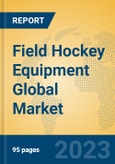Introduction
Field hockey equipment, including sticks, protective gear, and accessories, supports a growing global sport with over 30 million players (FIH 2023 report). The market is driven by increasing participation, particularly among youth, and innovations in lightweight, durable materials. Rising female participation (45% of players) and eco-friendly designs further boost demand. The global field hockey equipment market is projected to reach USD 4.0-7.0 billion in 2025, with a CAGR of 3%-8% through 2030.Regional Analysis
- North America: The U.S. and Canada grow through youth leagues and school programs.
- Europe: The Netherlands, Germany, and the UK lead due to strong hockey traditions and professional leagues.
- Asia Pacific: India and Australia drive growth with cultural affinity and government-backed sports initiatives.
- Rest of the World: Argentina and South Africa expand due to rising sports infrastructure.
Type Analysis
- Gears and Accessories: Expected growth of 3.2%-8.2%, driven by demand for protective equipment. Trends focus on lightweight, breathable materials.
- Equipment: Projected growth of 3.0%-8.0%, with sticks and balls leading due to technological advancements in composites.
Distribution Channel Analysis
- Online Retail: Expected growth of 3.5%-8.5%, driven by e-commerce and direct-to-consumer brands.
- Specialty & Sports Shops: Projected growth of 3.2%-8.2%, with consumers preferring in-store trials.
- Department & Discount Stores: Growth of 3.0%-8.0%, targeting casual buyers with affordable options.
Key Market Players
Leading firms include Adidas AG, offering performance gear; Grays of Cambridge, specializing in sticks; OBO Hockey, focusing on goalkeeping equipment; Kookaburra Sport, emphasizing durability; Mazon Hockey, targeting youth; Gryphon Hockey, innovating in composites; Bauer Hockey, STX, Dita Hockey, and Voodoo Hockey, advancing niche and premium products.Porter’s Five Forces Analysis
- Threat of New Entrants: Moderate, due to brand loyalty and manufacturing expertise, though innovative startups can enter.
- Threat of Substitutes: Low, as field hockey requires specialized equipment.
- Bargaining Power of Buyers: Moderate, with consumers seeking quality and affordability.
- Bargaining Power of Suppliers: Low, due to multiple material suppliers.
- Competitive Rivalry: High, with brands competing on innovation and performance.
Market Opportunities and Challenges
Opportunities:
- Growing participation (30 million players) and female involvement (45%) drive demand.
- Eco-friendly materials and youth-focused products expand markets, particularly in Asia.
Challenges:
- High equipment costs limit adoption in developing regions.
- Limited global awareness of field hockey restricts growth.
This product will be delivered within 1-3 business days.
Table of Contents
Companies Mentioned
- Adidas AG
- Grays of Cambridge
- OBO Hockey
- Kookaburra Sport
- Mazon Hockey
- Gryphon Hockey
- Bauer Hockey
- STX
- Dita Hockey
- Voodoo Hockey








